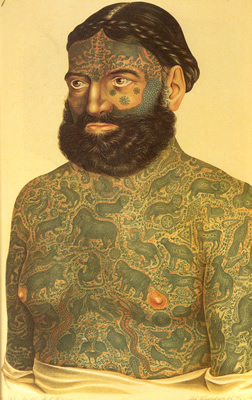




click on thumbnails below to see
The Tattoos:
History Archaeological evidence of tattoos exists from 6,000 year old European sites, on mummies dating to 2,000 B.C. in Egypt’s Middle Kingdom and was practiced among Central American peoples, Asian and Polynesian cultures, North American and Australian indigenous peoples (Hewitt 1997:68; Sanders 1989:9). A 5,300 year old frozen body found in the Austrian Alps in 1991 had charcoal tattoos on his legs and feet (Spindler 1995). Tattooing was practiced in pre- and post-Christian Europe and the Middle East; tattooing and self-mutilation is referenced in both the Old Testament and the Koran. Religious tattoos in later times were acquired by Coptic, Syrian, Russian, Abyssinian and Armenian pilgrims returning from the Holy Land (Hewitt 1997:66). Captain James Cook encountered the Tahitian “ta-tu” when in the South Pacific in the 1760’s and brought tattoos back to England as curiosities. Tattoos took hold in late 19th century Europe and America as colonialist symbols of the exotic and primitive; of the cultural “other.” Tattoos entered the North American sphere as the “custom of criminals, sailors, prostitutes, manual labourers, and other disreputable types… a symbol of social marginality” (Sanders 1991:151). Before you settle on a design, see what is available in 20th Century Tattoos. |
 |





'Under the Skin', Copyright 2004, Tony Hewer.

